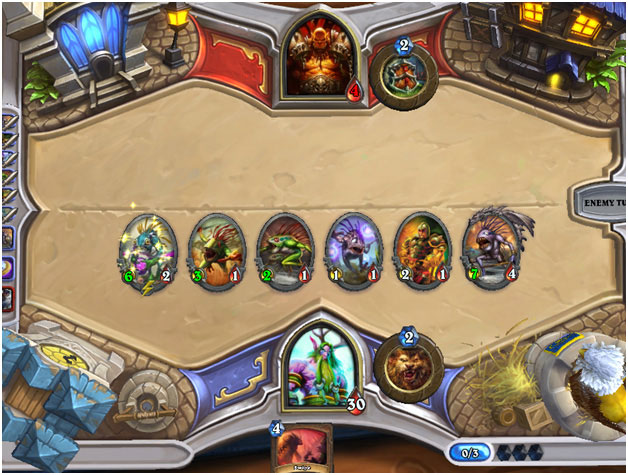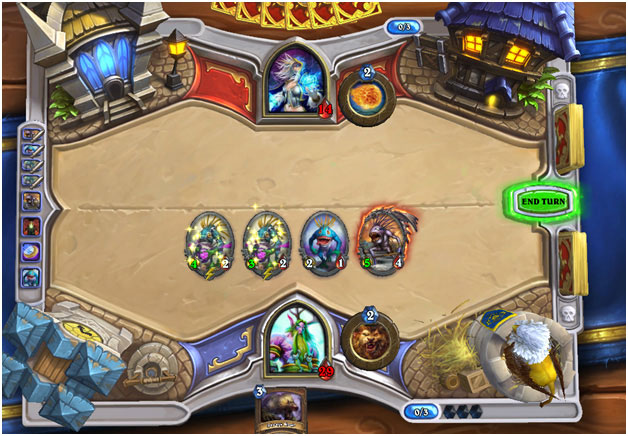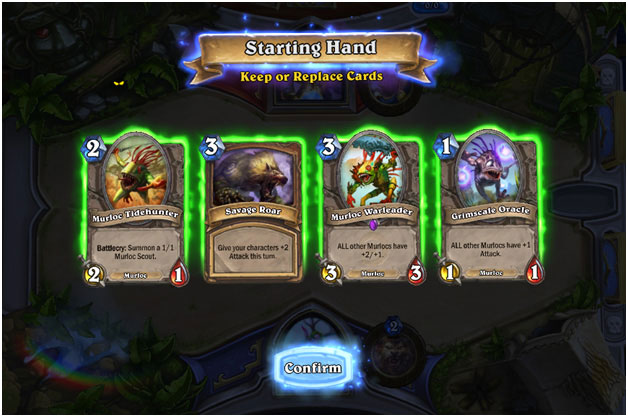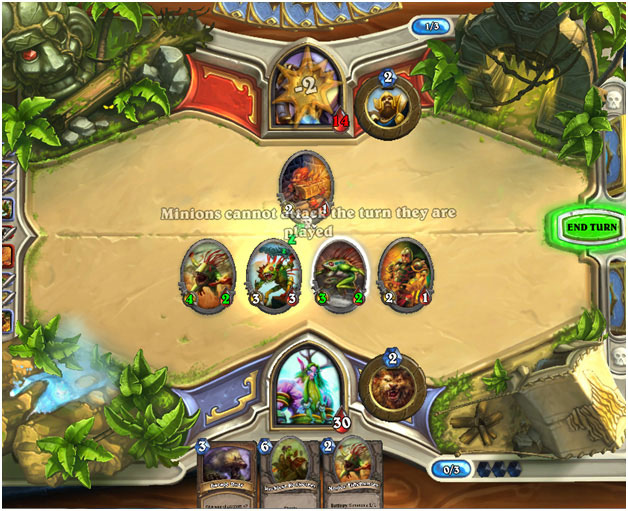MRGLGRGL, OR HOW I LEARNED TO STOP WORRYING AND LOVE THE GURGLE - A DRUID MURLOC BLITZ PRIMER
*Mrglgrgl*
That's the noise that keeps control players awake at night, the noise that makes Combo Hunters and Rogues cry themselves to sleep. Alright, maybe not, but it's the noise of the fastest and most aggressive deck in Hearthstone. Druid Murloc Blitz is a deck that relies on beating the opponent in the face quickly, often putting him under 10 health by turn four. And while it isn’t consistent, it makes up for that with its explosive draws that are difficult for all but Shamans to deal with.
Why you should play Druid Murloc Blitz: Druid Murloc Blitz has one of the most explosive early games you can imagine, with Innervate allowing you to throw together some absurd early game scenarios with Murloc Warleaders and Coldlight Seers. It also has access to Savage Roar, which is two turns quicker than Bloodlust and also allows you to use your own face to clear the way.. And the deck, in total, costs a meagre 3900 dust, and can go lower with substitutions that don’t substantially affect the power level of the deck. If you are a fan of beating opponents to death by turn five, DMB is the deck for you.
Why you shouldn’t play Druid Murloc Blitz: If you’re expecting long fulfilling games of Hearthstone, this is not the deck for you. The deck is incredibly high variance, relying on its first few draws to try to overpower the opponent. The deck mulligans often, and doesn’t mulligan well, which isn’t the most endearing quality for a deck to have. It also lacks card draw, so it finds itself in topdeck mode very often, having to rely on swingy cards like Old Murk Eye, Leeroy Jenkins, and Force of Nature to pull it out of the position it put itself into. Finally, it has a bad matchup against Control Warrior and an even worse one against Control Shaman (Lightning Storm has blown us out before we even had the chance to begin) .

Decklist
Druid Cards
- [0] Innervate - 2x
- [1] Claw - 2x
- [2] Power of the Wild - 2x
- [3] Savage Roar - 2x
- [4] Keeper of the Grove - 1x
- [4] Soul of the Forest - 1x
- [4] Swipe - 2x
- [6] Force of Nature - 2x
Neutral Cards
- [1] Abusive Sergeant - 2x
- [1] Grimscale Oracle -2x
- [1] Murloc Tidecaller - 2x
- [2] Bluegill Warrior - 2x
- [2] Murloc Tidehunter - 2x
- [3] Coldlight Seer - 2x
- [3] Murloc Warleader - 2x
- [4] Leeroy Jenkins
- [4] Old Murk-Eye
Potential Substitutions for Budget Considerations
[6] Reckless Rocketeer for [6] Force of Nature - Force of Nature is a great spell, but its rather niche and as an epic, not usually something a player will have in his collection. Reckless Rocketeer is a fine replacement that has the same effect of being a good top-deck in the late game, but is undoubtedly worse than Force in conjunction with Savage Roar, as Force threatens 14 damage and Rocketeer only threatens 9..
[5] Druid of the Claw for [4] Leeroy Jenkins - Leeroy is one of the best aggressive cards in the game, undercosted for a Battlecry effect that you don’t care about. Even if they trade the two summoned Whelps for Leeroy on the next turn, he’s done his job by throwing six to the enemy’s face. However, as a Legendary, he’s quite expensive and for those that lack him, Druid of the Claw can make a decent, if not great, replacement.
Card Choices and Omissions
[1] Drops - Omitting Murloc Raider, Including Abusive Sergeant - In theory, Murloc decks want to play as many Murlocs as they can, as the tribe thrives on putting down individually weaker members of the tribe which it then boosts with “lord” effects like Grimscale Oracle and Murloc Warleader. However, Murloc Raider, while a member of the tribe, is the one that carries the least weight. As a 2/1 for [1], it is a decent body to hit the enemy with, but we’ll often see it get burnt away by the first removal spell and discarded. It is also an atrocious topdeck in a deck that needs as many good ones as possible. Abusive Sergeant, while being the same body as Murloc Raider, has the added benefit of a Battlecry effect that in essence gives him Charge. This Attack bonus can be used to trade with a frustrating Taunter, or simply to throw more damage into the enemy’s face. What’s important is that he has an immediate effect on the board, while Raider does not.
[3] Drops - Omitting Coldlight Oracle, Including Two Coldlight Seer - This is often the most contentious part of my list and I often wane on this myself, sometimes reverting to a one of each list. However, while Seer’s Battlecry might not help us get more damage in immediately, it allows us to continue getting that damage in over the damage based removal of our opponent. Cards like Explosive Trap, Holy Nova, and Blade Flurry are made much less effective when our cards are still able to get through to do damage the following turn. As such, in an environment that loves to use damage to kill our brood, Seer is a strong choice. Oracle is an option for card draw, but has the downside of having our opponent draw cards. If we’re ahead and play him for more gas, we risk giving our opponents the answer they need; if we’re behind and play him to save ourselves, we risk giving our opponents the means to close out the game. Normally, we’re better off not playing him at all, and it’s not great to throw a card we often don’t even want to play into our deck.
[4] Keeper of the Grove over [5] Druid of the Claw - Druid of the Claw seems like a natural fit at the top-end of our deck’s curve, and he’s a suggested replacement for one of the strongest cards in our deck. However, if there is one thing this deck folds to early, its high impact Taunters like Ironbark Protector or Abomination, which can stonewall even the strongest Murloc rush. Keeper of the Grove gives us an answer to these terrifying cards by letting us try to ignore and race them. Keeper also gives us an answer to high health Legendaries like Ysera and Malygos that would otherwise cost us our whole team to kill. Keeper’s downside is that he’s underwhelming after he hits the board, but having at least one answer to those cards in our deck makes that a necessary sacrifice.
[1] Claw, [4] Soul of the Forest, and [4] Swipe over [5] Nourish - One of the earlier complaints I had with the deck was its lack of card draw, and as Coldlight Oracle isn’t the ideal choice to add that into the deck, another suggestion often made is Nourish. Nourish’s first line of text (Gain two Mana Crystals) doesn’t exist for us, as there is almost certainly no line in which that is the correct play. So, if we’re worried about the poor card draw of the deck, why not play Nourish over Claw or Swipe, or our miser Soul of the Forest? It's because Nourish isn’t that great a card for us - we’re trying to win by turn six or seven and Nourish, while a tempting card, doesn’t directly add to our board position. Every turn we delay killing our opponent is a turn they might be able to stabilize by playing a boardwipe or removal spell.
Claw is usually used to remove irritating engine cards like Northshire Cleric, Mana Tide Totem, and Warsong Commander, while Soul of the Forest removes cards like Flamestrike, Holy Nova, and Blade Flurry as outs after you’ve overcommitted to the board. Swipe can be used as a removal spell, but is just as often used to slash our opponent in the face for direct damage. These cards either delay stabilization or help us ignore our opponent’s attempts at it. Nourish, while a great card, is too slow for us to use effectively.
Game Plan
DMB does not want to throw down as many Murlocs as possible. We’re not just blindly going to throw down our entire hand and hope that the enemy doesn’t have an answer (they will). The goal is to throw down as many Murlocs as safely as possible, our sequencing should be such that our “lord” effects do not need to be out on the field for more than one turn to have an effect because they will almost certainly be removed before our next attack. There are exceptions to this rule of course - if you are able to Innervate out a Warleader on turn one against a class that isn’t Priest or Mage, you do it.
This isn’t to say that we don’t want to throw down our Murlocs as quickly as possible though. Take the initial hand against Mage of Murloc Tidecaller, Murloc Tidecaller, Innervate, Savage Roar, Coin. We draw Innervate and throw down the Tidecaller turn one. They respond turn two by playing Loot Hoarder. On turn two, we draw Bluegill. However, with two Innervates, it's a free card, and so instead we eat the Hoarder with our Hero Power and Coin out the Tidecaller (In the photo below I accidently Innervated out the Tidecaller, a horrendous misplay). Our Mage opponent takes turn three to Arcane Intellect and we draw Old Murk Eye. At the beginning of turn 3, our opponent had 28 Health.

By holding onto our Bluegill for another turn, not only did we give Murk Eye another point of damage, but we lulled our opponent into thinking that our hand wasn’t as explosive as it actually was and she paid the price for it. However, you can’t fool yourself into waiting too long to throw down your “lords” and Savage Roars, otherwise you’ll soon have nothing to buff. The golden spot to go for damage is turns three and four - you’ll almost certainly have the advantage on the board at this time and a four minion Savage Roar in the early game is 10 damage, which is nothing to scoff at.
Mulliganing
One of this decks biggest difficulties is knowing what to mulligan away in the early game. Since the deck revolves so much around a good start, poor mulligans can result in awful results with our gurgling brood. And even knowing how to mulligan with the deck doesn’t mean that you’ll be left with a great start - throwing away that Force of Nature might just draw you a Soul of the Forest.
Always Mulligan - [6] Force of Nature, [6] Reckless Rocketeer, [5] Druid of the Claw, [4] Soul of the Forest. In the case first three, their purpose in the deck is to be good topdecks, and they only serve to clutter up our opening hand. We want low cost Murlocs to build up a substantial board presence and these cards do not fit into that plan. Soul of the Forest is often an awkward draw and an awkward topdeck, but we need to have creatures in play to begin with to use its effect.
Sometimes Mulligan - [4] Keeper of the Grove, [1] Claw, [3] Coldlight Seer, [4] Old Murk Eye, [4] Leeroy Jenkins, [1] Grimscale Oracle, [4] Swipe. Choosing when to mulligan these cards depends on the matchup you’re in:
[4] Keeper of the Grove: Keeper is at his best against Warlocks and Hunters. Against the former, he can either some of the bigger threats big Warlock puts up or kill the Blood Imps/Voidwalkers of Zoo. Against the latter, he can kill a wide variety of beasts, silence Hyena and Highmane, and negate Houndmaster’s Battlecry. Outside these two matchups, throw him back.
[1] Claw: Best against Priest to eliminate Northshire Cleric or Warlock/Hunter to kill off something. If you feel like there is going to be an important early creature drop by the opponent, keep this in your hand.
[3] Coldlight Seer: Keep against Hunter (Explosive Trap), Priest (Holy Nova), Shaman, Warrior, or Mage. Throw back against Warlock.
[4] Old Murk Eye: Really depends on not the matchup, but the rest of your hand. Keep if you have 2-3 other Murlocs in your hand (counting Tidehunter as two).
[4] Leeroy Jenkins: Keep against Rogue and other decks you need to kill as quickly as possible. Outside those decks, throw him back as he is a better topdeck than perhaps anything else in your deck.
[1] Grimscale Oracle: Similar to Murk Eye, relies on your hand having a concentration of Murlocs. Throw back against decks with easy 1 damage removal (Rogue, Shaman, Warrior, Mage).
[4] Swipe: Keep against Paladin, Shaman, Hunter, and Warlock. Your only mass removal spell, so keep it if you feel like you might be on the defensive during the game.
Always Keep - [1] Murloc Tidecaller, [0] Innervate, [3] Savage Roar, [3] Murloc Warleader, [2] Murloc Tidehunter, [1] Abusive Sergeant, [2] Bluegill Raider. These are cards that provide you with a really strong board presence early while hitting them for enough damage that your topdecked creatures will serve as a real threat later. The most tenuous of all of these is Innervate, but it's seldom that the card is a good topdeck and it can put you into strong positions early.
Sample Hand Against Paladin

In this case, I chose to keep the Tidehunter/Roar/Warleader, and throw back the Oracle. I figured Oracle was a useless turn one play against a deck that would simply trade away its Hero Power for it, and Coin/Tidehunter would put me in a stronger position.

As you can see, the mulligan went well, getting Abusive Sergeant as my replacement. I hit my opponent for 5 on turn two, and then 9 on turn three, finishing it with a Roar on turn four.
Conclusion
One of the biggest concerns of Murloc Blitz is that as the meta has evolved, the archetype has stayed rather stagnant. The Warlock Murloc decks died out in favor of Zoo, and Shaman Murlocs hasn’t been effective for a while as Shaman, as a class, has moved more towards control. However, I still believe there is room for an aggressive Murloc deck, and I think Druid Murlocs is just what is needed. While the deck won’t always kill by turn four, it threatens to kill far earlier than any other deck in the game and it takes advantage of the expectation that Druids will be aiming for the long game. That isn’t to say that this deck is a panacea for the problems Murlocs have. It has an atrocious matchup against Shamans and Warriors, and certainly has issues with some Zoo draws. It still has problems getting through Chillwind Yeti, and while Soul of the Forest is an answer to boardwipe, it’s a clunky one at best. Despite these flaws, the deck is able to race some of the most popular decks (Miracle Rogue, Beast Hunter) in the meta, and can kill before some of the more devastating removal spells (Holy Nova, Flamestrike) come into play. So stop worrying and embrace the gurgle. I assure you, you won’t regret it.
Tristam Mizak